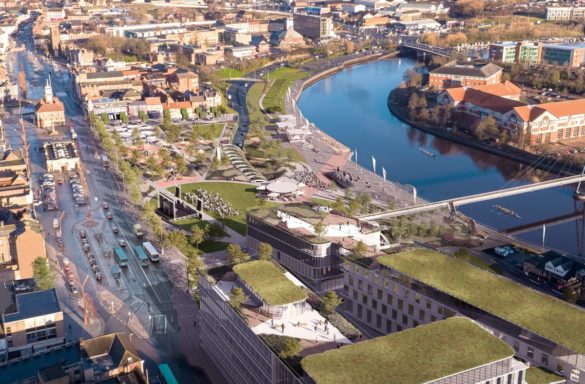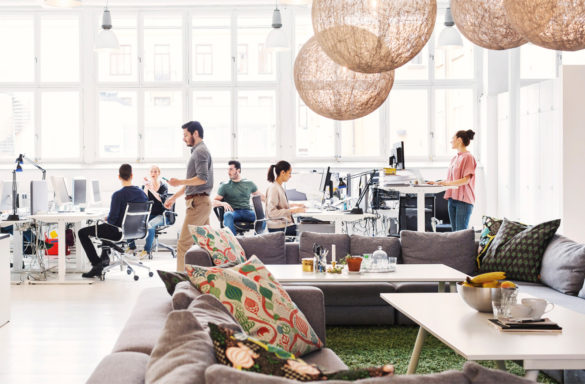ARTICLE
High streets need to find their ‘appetite for design’
62°19’12”N 9°16’06”E
In this call to action, Freestate global creative director Adam Scott is asking designers to help high streets become flexible, theatrical, community spaces.
The late and much vaunted designer Wajiro Kon argues that we humans experience urban space as theatre, and that we describe that space with our bodies. Such spaces, he said, are vital – socially, meaningfully and sensually.
You’ll no doubt have your own example of Kon’s living theatre, but one of my go-to favourites is the ever-morphing market that’s sprung up on the entrance floor to Old Street tube station, somewhere so successful as to draw commuters out of the bowels of the earth to enjoy this particularly vibrant theatre while all the world above negotiates the endless pale grey of possibly one of London’s ugliest roundabouts.
Curated by Appear Here, vibrantly colouring in the nooks and crannies of a late-Victorian underground space, programmed for surety and surprise, and possessed of a beautiful and ever-changing DIY punk activism, the design here is everything Kon might expect of the high street as necessary theatre: a place that understands the wants and needs of people as social, curious, and creative beings.
High streets have gone to the dogs
Unfortunately, Old Street is a rare bird. The average British high street is a proper goner, a fact that can’t be laid at the door of the internet or a virus called COVID19. Truth is, it’s been a generation-long disaster zone.
Our grey-faced addiction to big-box chains, out-of-town retail centres, faux localism templates, and retail agency bread-and-butter rollout programmes, speaks to the fact that whoever’s been driving the British retail and hospitality bus has been asleep at the wheel for a jolly long time.
The result, I’m afraid, is the opposite of everything Old Street stands for. Gone from the average high street is the experience of loving being out, the joy of being together, in the street, alive. Our streets look like they’ve been designed by zombies for zombies. It’s apocalypse now by template. It’s all gone to the dogs.
The reasons as to why it has are legion, and well beyond the remit of this article. However, it’s a demise that coincides with the gradual disappearance of an appetite for design. I’m not talking here about urban planning and straight architecture, though that’s part of it. I’m talking about – and in no particular order – the loss of the impresario, the art director, the graphic designer, a culture-obsessed communications expert, the storyboard illustrator, the set designer, the multi-media artist, the scenographer, the theatre director, the script writer, the service designer, sound and lighting.
I’m talking about the increasingly rare ability to respond punk-like to a design brief for the high street – locally, originally, brilliantly. I’m talking about the highly endangered theatres of a Harry Selfridge, Appear Here’s Ross Bailey, or Market Halls by Andy Pratt.
This Poundland store became vacant and was replaced by Catford Mews.
Green shoots of punk are emerging
Ironically, the pandemic’s super-charging of the inevitable death of the retail-led high street presents the most extraordinary opportunity for a design-led renaissance. Survival dictates a high street composed less of straight retail and hospitality, and more of a rich campus-like mix of activities; a blur of traditional retail, hospitality, workplace, entertainment and, less obviously, healthcare, education, and experience-based pop-ups.
It’s the agora born again, a rebirth that promises much for the above-mentioned lost designers, and which, like Appear Here’s reappropriation of Old Street, couldn’t be more informed by the local, be that socially, physically, or culturally. Again, examples of these green shoots of punk activism abound, but for our immediate design-conscious purposes, below is a very quick glance at two fine new-old typologies: they are the entertainment-hospitality wonder that is Catford Mews and the education-in-the-face-of-retail Migration Museum.
Catford Mews was brought to bear by the Really Local Group working with Wren Architecture & Design, and Lyttelton Yates – which designed the interiors. It is a reappropriation of a vacant Poundland store, while the Migration Museum is a similarly bold takeover of a Lewisham-based ex-H&M unit.
Small and singularly focused, the first sees a brutalist building occupied by an entertainment cluster designed to attract residents back onto the streets. A mash-up of food market, cinema, community hall, music bar, café, and live music venue, its design – architectural retrofit and activation programme – is deeply sympathetic to the very local.
The second sees the hitherto mainly itinerant Migration Museum land slap-bang in the middle of a traditional retail landscape; it’s entrance a pair of illustrated pieces of the Berlin Wall, its subject matter an education, all while delivering a design-led prod in the side of profit-driven capital.
Critically, what marks the likes of Catford Mews and Migration Museum out from the dead and the dying is the fact that they’re all part and parcel of the design of the high street as a meaningful prototype. They’re the punk DIY activism born in times of recession, times when empty units and an us-and-us approach actively rails against driving people through the proverbial gift shop. They’re the high street as fast-moving content, where the small and the nimble rule, and real-world experience is returned once again to the theatre of public space. They’re the art installation morphing into the market stall, the pop-up restaurant, the maker festival, the seasonal enterprise scheme and the modular neighbourhood centre. They’re opposite of today’s Oxford Street.
The Migration Museum, which took the place of a vacated H&M store, displays two sections of the Berlin Wall outside its entrance
Such a street is all about the adaptive reuse of the redundant space often built into present infrastructure. It’s where the unexpected juxtaposing of wildly different typologies births a radically new form. It’s the street that forsakes the car for the tram, for parks, trees, and bikes, for a sturdy pair of walking shoes, for unexpected nature. It’s the public space as revolutionary theatre, an open system or platform, as enabled by the socially conscious landlord, and nourished by the independent, the rare, and the locally familiar. It’s where we go out to play, to create, to be Kon’s social, sensual, and meaningful beings. This is the domain of the impresario, the maker, the storyteller. It’s the work of the theatre designer, the art director, the event manager, the live producer. It’s the creation of a brand-new star: the designer of the high street as a perpetual field test.
Your highstreet needs you
Whatever lockdown’s been for you, guaranteed you haven’t missed the universal background of grey and glass that marks our working days. Or the cookie-cutter global franchises whose efficiently gridded floorplans defy what it means to be in a certain place, among a certain people, experiencing a certain way of being. On the contrary, what we have missed is the small-fast-moving programme-led experiences. We’ve missed the memory making machine – the intimate and personal, the stuff of life, the joy of the crowd. We’ve missed being together. Which is why, dear designer, we shall end with a call-to-action: Your high street needs you. It needs the careless caring you, the student you, the fuck-the-money-I’m-doing-it-anyway you, the love-they-neighbour you. It needs your inner punk. Let’s be having you. Let’s go make a theatre.
Some of Adam Scott’s ideas are explored in this new book, Rethink design guide: architecture for a post-pandemic world
This article was first published on Design Week’s website.
Image credit: Taran Wilkhu



